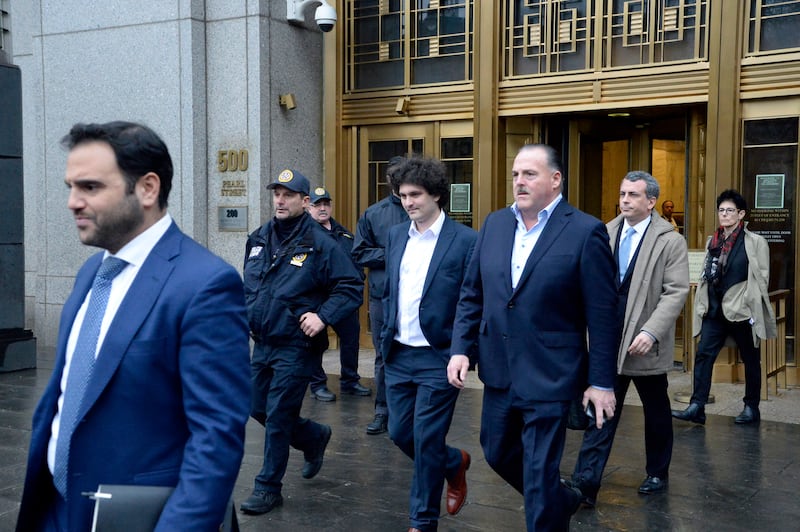Over and over on Tuesday, Sam Bankman-Fried, founder of the failed FTX cryptocurrency exchange, denied knowing that billions of dollars in customer money had been misappropriated until shortly before his company collapsed last year, as a federal prosecutor grilled him for a second day in his criminal fraud trial.
The 31-year-old onetime crypto mogul fumbled for an answer when the prosecutor, Danielle Sassoon, repeatedly asked whether he had told his employees not to spend FTX customer money on investments, pricey real estate and other expenditures. Bankman-Fried also couldn’t name any employees who might have authorised the use of FTX customer money for that spending.
“I don’t recall giving any direction,” Bankman-Fried said three times about the spending of FTX customer money before he concluded his testimony. Both sides rested their case before lunchtime Tuesday, with closing statements set to unfold on Wednesday.
Bankman-Fried was on the stand for a third day testifying before a jury in his own defence in a trial that has come to symbolise the highs and lows of the volatile crypto industry. The entrepreneur has been accused of masterminding a years long fraud to steal as much as $10 billion from FTX’s customers and then funnelling the money to extravagant real estate purchases and other spending, as well as using the funds to prop up a crypto trading firm he also founded, Alameda Research.
If planning laws were changed, obsolete offices could be converted into housing to ease Dublin’s rental crisis
Johnny Lappin: ‘I got scammed by a rogue so-called roofing contractor. I foolishly paid him in cash’
The silence of the CEOs in the face of Donald Trump’s tariff chaos
Big pharma sees positive side effects in Trump tariffs
FTX, which was valued at $32 billion at its peak, imploded spectacularly last year, leaving many customers unable to recover their deposits. Bankman-Fried has pleaded not guilty to seven counts of fraud, conspiracy and money laundering. If convicted, he could face what amounts to a life sentence.
The first few weeks of his trial were filled with a procession of prosecution witnesses who have pointed the finger squarely at Bankman-Fried and said he directed them to commit crimes. Three of his closest associates – Caroline Ellison, Nishad Singh and Gary Wang – have pleaded guilty and agreed to co-operate with prosecutors.
The pileup of damaging testimony may have forced the FTX founder’s hand in testifying, a risky move for a criminal defendant. Taking the stand gave Bankman-Fried an opportunity to say that he never intended to defraud anyone and that his business decisions were made in good faith. But it has also allowed prosecutors to zero in on his past public statements and contrast them with what he did in private.
When Bankman-Fried initially took the stand Friday, he took questions from his lawyer, Mark Cohen. Bankman-Fried denied that he had committed fraud or stolen from FTX’s customers, but also acknowledged that he had made mistakes, citing “significant oversights” that hurt the exchange’s customers.
On Monday under cross-examination, Sassoon pressed Bankman-Fried about inconsistencies between his public statements and how he ran his crypto empire. He often insisted that he couldn’t remember much of what he had said publicly.
On Tuesday, the cross-examination continued, focusing on the actions and statements Bankman-Fried made leading up to the implosion of FTX in November. Bankman-Fried, wearing the same grey suit and purple tie as in previous days on the stand, testified in front of a crowded courtroom that included Damian Williams, the top federal prosecutor in New York. Missing from the gallery was Bankman-Fried’s mother, Stanford law professor Barbara Fried, who had attended every previous day of the trial.

Sassoon, the federal prosecutor, was relentless, asking Bankman-Fried about the failure of FTX, including if some of the co-operating witnesses had not told the truth about Alameda Research owing billions in customer money to the exchange. Bankman-Fried previously testified that he did not learn about the missing funds until about October 2022, while other witnesses testified that he knew much earlier.
At one point, Sassoon asked Bankman-Fried if Adam Yedidia, a former FTX developer who testified at the trial, was lying when he said in court that Bankman-Fried had told him in the summer of 2022 that Alameda owed $8 billion to FTX customers.
“I don’t remember him saying it in that way,” Bankman-Fried replied.
Sassoon then asked if Ellison, who ran Alameda and was at one point Bankman-Fried’s girlfriend, was wrong when she testified that she and Bankman Fried had conspired with others to misappropriate FTX customer money.
“You didn’t tell your employees ‘Don’t spend FTX customer deposits?’” Sassoon asked at one point.
“I didn’t,” Bankman-Fried said. “I deeply regret not taking a better look into it.”
Sassoon also asked Bankman-Fried if he remembered offering favours to government officials in the Bahamas, where FTX was based. He said he didn’t recall giving Bahamian Prime Minister Philip Davis and his wife courtside tickets to the FTX Arena in Miami. The jury was then shown screenshots of messages of him saying exactly that. (The arena has been renamed.)
The prosecution also displayed emails in which Bankman-Fried offered to open withdrawals for Bahamian customers after FTX had halted customer withdrawals as people tried to get their money out from the exchange last year. FTX was under investigation by Bahamian regulators at the time.
During a brief redirect, Bankman-Fried tried to clarify that he did not know who at Alameda had authorised the spending of FTX customer money. FTX had about two dozen employees, he said, and “I wasn’t particularly interested in trying to dole out blame.”
After closing statements Wednesday, jurors could start deliberating a verdict in the case as soon as Thursday. – This article originally appeared in The New York Times.
2023 The New York Times Company














